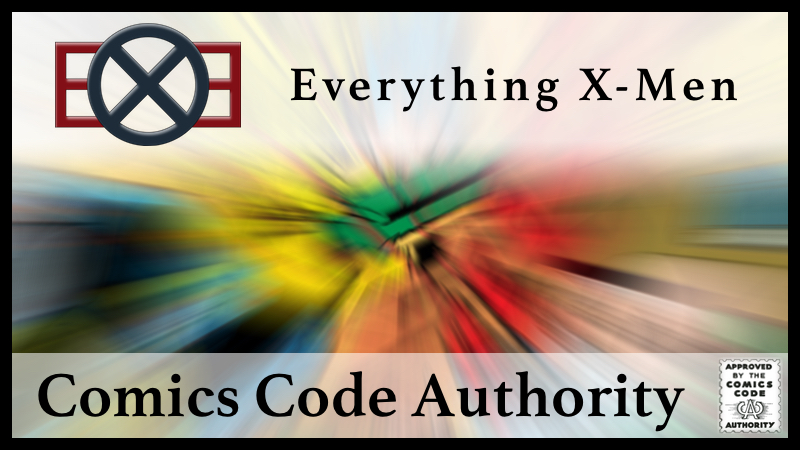
“Put your tiny hand in mine
I will be your preacher teacher
Be your daddy
Anything you have in mind”
(“Father Figure”, George Michael)
 Did you ever notice the stamp-like figure on the right top corner of your comic books? To be honest, the first time I consciously saw them was while reading the Jack Kirby & Stan Lee run of the X-Men. Now that I am aware of them, I see them each time I read older comics – for example, the Batman storyline No mans land. Even there, very tiny and barely visible, is the logo of the CBA. First, I thought, “nice, a quality sign for comics.” You know, like meat or vegetables or eggs sometimes get those stamps to prove they are worth your money?
Did you ever notice the stamp-like figure on the right top corner of your comic books? To be honest, the first time I consciously saw them was while reading the Jack Kirby & Stan Lee run of the X-Men. Now that I am aware of them, I see them each time I read older comics – for example, the Batman storyline No mans land. Even there, very tiny and barely visible, is the logo of the CBA. First, I thought, “nice, a quality sign for comics.” You know, like meat or vegetables or eggs sometimes get those stamps to prove they are worth your money?
Then I started to read about this Comics Code Authority and began to understand that this is the worst thing to have happened to comic books, ever. This little organization, which was deliberately founded by the publishers themselves, ruined some of them, censored the rest, and restricted the writers and artists. From 1954 until 2011 (yes, you read right) the Comics Code Authority approved comics of various publishers.
Milestones?
I don’t want to summarize the whole history of the Comics Book Authority because Dr. Amy Kiste Nyberg did a great job covering this incredible story on the website of the Comic Book Legal Defense Fund (cbldf.org). It is a quick read, and I recommend it, if you are interested in this topic. However, here are some cornerstones of the CBA’s history:
- The first version of a regulatory code was released in October of 1954.
- “Only comics that passed the pre-publication review carried the seal” (Nyberg, n.d.).
- The Authority was founded because comic book critics (churches, parents, and others) feared that they might have a bad influence on their kids.
- Dr. Frederic Wertham, a psychiatrist, campaigned to ban comics from children and even wrote a book about it: Seduction of the Innocent.
- Crime comics were especially said to be responsible for Juvenile Delinquency (putting bad ideas into children’s heads).
- William Gaines, a publisher of EC Comics, was “disgusted with the direction events had taken” (Nyberg, n.d.) and he refused to let the CMAA (Comics Magazine Association of America) approve his comics. Consequently, he was forced to end his comic business and started MAD magazine.
- With the release of a three-part Spider-Man story, which Stan Lee did not let the CMAA approve, the code was revised in February 1971.
- In the 1980s, the comic book distribution changed to a direct market distribution, which meant that more publishers bypassed the code.
- 1982 was the last revision of the code.
- DC Comics and Archie Comics were the last publishers to drop the Seal of Approval–mind you, this was in 2011 (!)
Behind the Curtain
Just to get an idea of how the Seal of Approval and the code behind it impacted a whole industry, check out the website seductionoftheinnocent.org. It is a very resourceful site. They try to collect every comic book Wertham used as “proof” that comics were a bad influence on children. Furthermore, they have a lot of interesting articles linked, which discuss the topic in more depth. The full code of 1954 can be found here lostsoti.org. But, as before, here are some examples of what was in the original version:
- “No comic magazine shall use the word horror or terror in its title.”
- “The treatment of live-romance stories shall emphasize the value of the home and the sanctity of marriage.”
- “Profanity, obscenity, smut, vulgarity, or words or symbols which have acquired undesirable meanings are forbidden.”
- “If crime is depicted it shall be as a sordid and unpleasant activity.”
- “Crimes shall never be presented in such a way as to create sympathy for the criminal, to promote distrust of the forces of law and justice, or to inspire others with a desire to imitate criminals.”
- And so on and so forth…
In my opinion, the code was like a self-fulfilling prophecy. Mind you that comics were a somewhat new medium at that time–at least in the format we recognize. The first comic strips were published by Switzerland’s Rudolphe Töpffer back in 1827. This was followed by a few graphic novels, but the first modern American comic book was published in the early 1930’s. Famous Funnies: A Carnival of Comics was released in 1933 and Famous Funnies #1 was released in 1934.
At the time when crime and horror comics were a big thing, critics came along with it: concerned for their children and what effect the comics might have on them. So, first, comics were attacked by people who did not understand the medium. Then, instead of talking to the audience and telling them that not every comic book is necessarily for children, the publishers founded the authority.
Establishing Something New

I have the luxury of taking a modern perspective on the topic, and today the audience of comics seems to be very diverse. No matter how old you are, skinny or fat, black or white, straight or queer, comics are for everyone. You have the major publishers, as well as indie comics, webcomics and a lot of niché markets. They are like TV shows or films: a medium, not a single format or a restricted way to tell stories. This might seem like something quite obvious, but I feel like that it is important to state it time and again: comics are not just one single format.
To get to this point takes time, patience and money. Especially money from the publishers. But if you introduce a new medium to the world, you cannot just censor it because some are offended by the way you tell your stories. Give it time to evolve. Not just the medium itself (as a publisher you have to figure out, what you can do with it), but also as the audience. Maybe without the Authority, we would have never got the superheroes we love and cherish. We would have something different, perhaps. Diving into this topic would be exciting. Asking questions like, what comics and stories were most popular at the time the critics came around? What content and tales could not be told because of the Authority? And then, speculating.
But we cannot change time. And a lot of stories and characters that were created during these decades are brilliant, intriguing and I would miss them a lot. They even spawned entire cinematic universes, inspired a whole new genre of films, and a new generation of writers, artists, and more. The truth is that the CBA censored the creators, and some stories may not be as suspenseful or original as they would have been. Was this the reason sales dropped? I don’t know; maybe we can talk more about that when we get to the ages of comic books.
Conclusion
To this day, I am surprised that all the major publishers supposedly agreed on the CBA. We are talking about a whole industry. How is that possible?
During my research, I stumbled upon sentences like the following: “In 1954 the Comics Code Authority was implemented due to an apparent link between the rising popularity of comic books and a rise in juvenile crime.” (comicvine.gamespot.com) It makes me angry to read something like this because what is this “apparent link” everyone talks about, but the only one who is quoted time and again is Wertham (if at all). There is a difference between correlation and causation. Is there any real scientific evidence, that statements like the one above is true? I am asking! If so, please let me know. It reminds me of a discussion we have today (an unnecessary one, I might add): can violent games be held responsible for killing sprees and such?
Fortunately, though, the code is no longer in use. But, it did some damage. Some publishers couldn’t sell their comics anymore, which resulted in their bankruptcy. For over 60 years, the comic book industry just gave up–at least in my opinion. As I said, comics were somewhat new at that time. Logically, there were concerns about them; there always are. But, you cannot blindly listen to critics, even when the sales drop. Just keep telling good, intriguing stories and people will find their way back. I believe in that.
Works Cited
- Wertham, F. (1953). What Parents Don’t Know About Comic Books. Ladies’ Home Journal, November, 1953.
- Nyberg, A.K. (n.d.). Comics Code History: The Seal of Approval (blog post). Retrieved September 25th, 2017 from cdldf.org




2 thoughts on “Everything X-Men: Comic Book Authority”